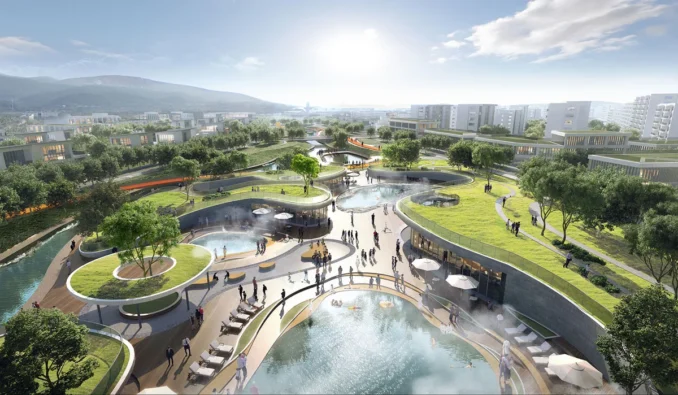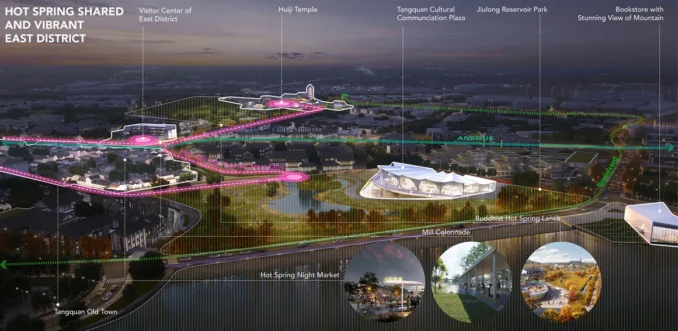
Tangquan Town in Nanjing, with a 1,600-year history, is known for its scenic mountains, abundant hot springs, ancient forests, and historic temples. The town boasts unique radon springs, with the highest geothermal water flow in Jiangsu Province. Traditionally, locals used these springs for health, but recent privatization and neglect have led to environmental decline.
In response, the design team, in collaboration with the government and locals, focused on creating a green, vibrant, wellness-oriented town. By considering the wind and heat environment and utilizing big data analysis, we proposed sustainable development and public access to hot springs, promoting healthy lifestyles for residents and tourists. Recent projects include a community kindergarten, an education base, a camping site at Jiulong Lake Wetland Park, and a citizen sports park, all contributing to the town’s organic growth and improved quality of life.
The design team developed two primary design strategies to guide the project: prioritizing health and publicizing hot springs.


Health Priority:
The first strategy focuses on optimizing the urban environment to promote human well-being. The team analyzed extensive data from thousands of small towns to recommend the optimal distribution of facilities related to hot spring tourism, such as hotels and commercial areas. This approach ensures balanced development, providing jobs for residents while meeting tourists’ needs, thereby fostering the town’s sustainable and organic growth.

In addition to the economic considerations, the team paid particular attention to the town’s unique wind and thermal environment. By restructuring the town’s open spaces, they created wind corridors that alleviate stagnant air in summer and reduce pollutants while blocking cold winter winds. This enhances the overall comfort and health of the town’s residents.

Supporting this strategy, the design includes the creation of a park system with an inner loop health trail connecting the entire town. This trail links with an outer loop that extends to Phoenix Mountain and Reservoir Park, offering residents and visitors diverse routes for walking, jogging, and cycling. These trails integrate the natural and built environments, encouraging a healthier lifestyle.
Publicizing Hot Springs:
The second strategy focuses on making the town’s hot spring resources publicly accessible. The team identified key hot spring sites and recommended the government reclaim and publicize them, ensuring they are available to everyone. The design integrates these hot springs into a slow-traffic network, creating themed routes that offer communal hot spring experiences for tourists, residents, and workers alike.

These themed routes are designed to enhance the visitor experience and foster a sense of community, with shared hot spring pools and multifunctional urban spaces providing diverse, accessible, and public hot spring experiences.

Sustainable Development:
To ensure sustainable development, the team also proposed strategies focused on ecological resilience and cultural tourism planning.
In terms of ecological resilience, the landscape design integrates the naturally formed wetlands, creating a dynamic wetland park. During periods of low water levels, this park offers additional public spaces for recreational activities, while during high water levels, it acts as a retention area to manage stormwater and reduce flooding risks. This system is complemented by a water resource treatment system that helps minimize water pollution, ensuring the preservation and sustainable use of the town’s natural resources.

The team planned two hot spring-themed routes. The first, the Wetland and Forest Tourism Circuit, connects the wetland park and wind corridor park with existing attractions such as the Phoenix Mountain hiking trail. This route offers visitors a chance to explore the town’s natural landscapes while enjoying the hot springs.

The second route, the Hot Spring Street and Alley Tour, links historical and cultural sites, including the old town streets and Huiji Temple, with hot spring resources. This route preserves the original community atmosphere while connecting cultural sites with new facilities and parks. The design aims to create a low-carbon, resilient, and ecologically regenerative Tangquan Town that respects and revitalizes its traditional roots.

Implementation and Future Growth:
Several key projects have already been completed, including a community kindergarten, a new education base, a camping site in Jiulong Lake Wetland Park, and a citizen sports park. These developments are the first steps in the town’s ongoing organic growth, contributing to the improved quality of life for both residents and visitors. The town is expected to continue its sustainable development, becoming a model for health-focused, ecologically resilient, and culturally rich urban living.

From Private to Shared Hot Springs: Urban Design for Nanjing Tangquan Town
Location: Pukou District, Nanjing, Jiangsu Province, China
Design Company: Urban Architectural Lab, Architects & Engineers Co, Ltd. of Southeast University (AESEU)
Lead Designer: Hua Liu, Dongqing Han
Design Team: Peng Gui, Ying Tang, Weiren Zhuang, Rui Lu, Lanjun Li, Yang Wang, Yuping Xu, Yacheng Song, Xin Zhou
Other Credit: Li Li, Yuan Meng, Fei Sun, Yu Li, Yiting Zhu, Zhenhong Gu, Yang Yu, Yin Lu
Client: Tangquan Street Administration, Pukou District, Nanjing
Photo Credit: Urban Architectural Lab, Architects & Engineers Co, Ltd. of Southeast University

Be the first to comment